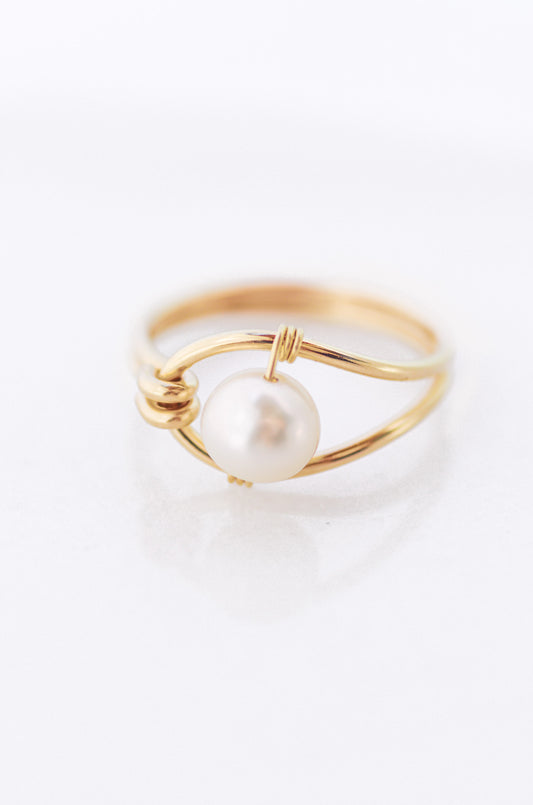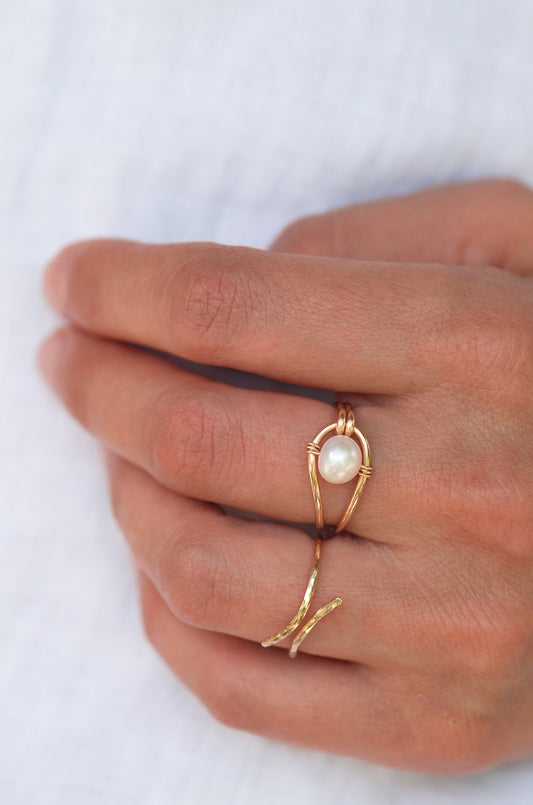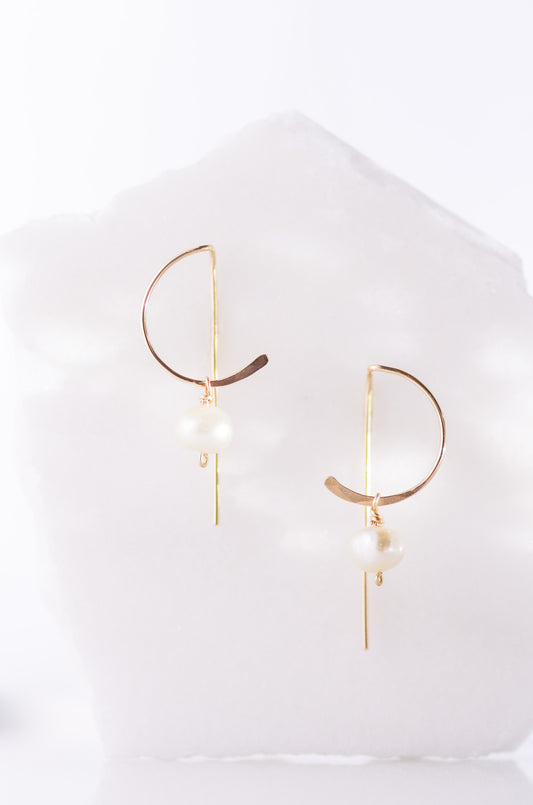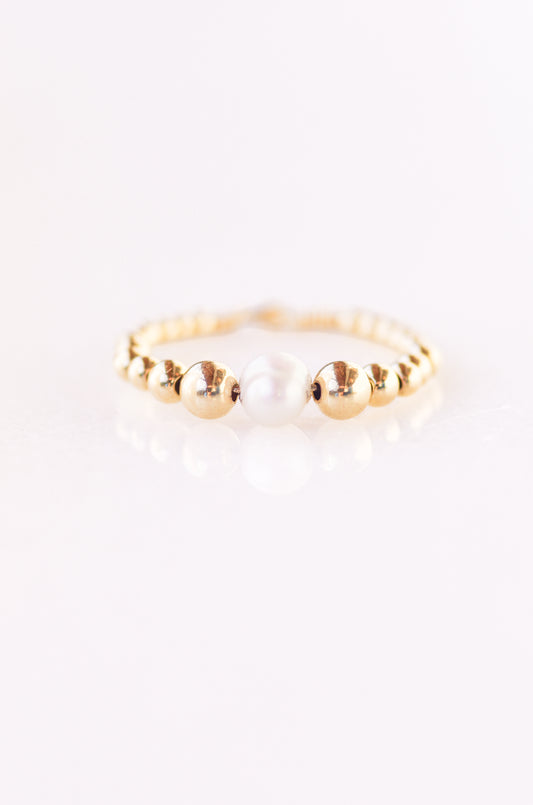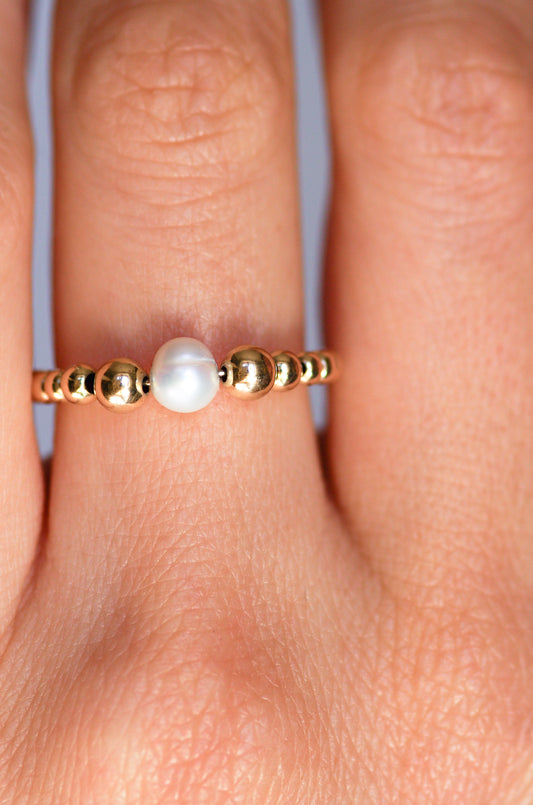5 Lessons from Building an Ethical Jewelry Brand
Share
- Choose Better Materials: Gold-fill jewelry lasts longer and avoids harmful chemicals used in gold plating. Recycled metals reduce carbon emissions by over 99% compared to newly mined gold.
- Source Ethical Gemstones: Vintage gems and pearls are a better alternative to untraceable stones, cutting down on mining and adding character to designs.
- Avoid Greenwashing: Transparency is key. Share sourcing details and avoid vague claims like “sustainable” without proof.
- Support Local Communities: Employing local artisans ensures fair treatment and reduces environmental impact. It also strengthens community ties.
- Design with Purpose: Focus on timeless, nature-inspired designs that reflect personal values and quality craftsmanship.
Each decision reflects a commitment to quality, ethics, and care for people and the planet. By prioritizing recycled materials, local production, and thoughtful designs, this approach challenges the norms of fast fashion and promotes meaningful change.
Lesson 1: Choose Better Materials
When I began building my ethical jewellery brand, the first big challenge was finding materials that aligned with my principles. The jewellery industry is flooded with cheap, harmful products that not only wear out quickly but also leave a lasting negative impact on the environment.
Switching from mass-produced materials to more responsible options meant taking a hard look at the entire supply chain. Every step - how metals are sourced, processed, and their impact on people and the planet - needed to be re-evaluated. This approach shaped the foundation for choosing materials that not only perform well but also respect the world we live in. Each decision became part of the brand's commitment to sustainability and integrity.
Why Gold-Fill is Better Than Gold-Plated
Gold-plated jewellery might seem like an affordable choice, but it’s often a short-term solution. The ultra-thin gold layer wears off quickly, sometimes within weeks or months. On top of that, the plating process relies on harsh chemicals that harm workers and pollute the environment.
Gold-fill, on the other hand, contains 100 times more gold than gold-plated jewellery and uses heat and pressure to bond gold to a base metal - no harmful chemicals involved. This results in a durable piece that can last for years, even decades, with proper care.
The benefits of gold-fill go beyond durability. It’s also a better option for people with sensitive skin, as the thick gold layer and chemical-free bonding process significantly reduce the risk of allergic reactions. From an environmental perspective, this method eliminates the toxic waste that typically ends up in waterways during plating. Gold-fill isn’t just a smart financial choice; it’s a cleaner, more sustainable option that doesn’t compromise on quality or appearance. If you’re building a jewellery collection meant to last, gold-fill is the way to go.
Of course, material quality is only part of the equation - ethical sourcing is just as important.
Choosing Ethically Sourced and Recycled Metals
Traditional mining for metals wreaks havoc on the environment, polluting water sources, destroying landscapes, and often exploiting workers in hazardous conditions. Shockingly, around one million children are estimated to work in mines worldwide under dangerous circumstances [2]. With this knowledge, I couldn’t justify using conventionally mined gold.
Recycled metals provided a solution that fit my values. Through purification processes, these metals are refined to remove impurities, resulting in materials that are just as strong, durable, and radiant as newly mined ones - minus the environmental and ethical concerns.
Using recycled gold reduces carbon emissions by over 99% compared to newly mined gold [1]. Similarly, recycled sterling silver generates only about 14% of the greenhouse gas emissions associated with mining silver [1]. These numbers highlight how significant the difference can be for the planet.
Recycled metals also contribute to a circular economy. Metals can be recycled endlessly without losing their quality, meaning every piece of recycled material helps prevent waste from ending up in landfills. It’s a system where resources maintain their value and purpose, rather than becoming environmental liabilities.
Ethical sourcing goes further than just environmental benefits - it’s about supporting fair wages, ensuring safe working conditions, and investing in local communities. Choosing recycled and ethically sourced metals is a way to back a supply chain that prioritizes both human dignity and environmental care. It’s a decision that reflects personal values while pushing for positive change in the industry.
Lesson 2: Find Ethical Gemstones and Pearls
After finalizing ethical metals, the next challenge was sourcing gemstones and pearls that aligned with my values. Gems, with their undeniable charm, are the heart of many jewellery pieces. Yet, the traditional gemstone industry is full of issues that often go unnoticed.
Unlike metals, which can often be traced back to specific mines or recycling facilities, gemstones are covered in a web of unclear claims and unverifiable supply chains. This lack of transparency made me rethink how I could incorporate stunning stones and pearls without compromising my principles.
The Problem with Gemstone Traceability
The gemstone industry has a major flaw: traceability is almost nonexistent. Many suppliers claim their stones are "ethical", but I quickly learned that these promises lack any real proof. Mining for gemstones not only harms ecosystems but also exploits workers, and the supply chain is so complex that tracing a stone to its origin is nearly impossible.
Faced with these realities, I decided to reject conventional practices and explore alternatives that aligned with my ethical standards.
Turning to Vintage Gems and Pearls
The solution came from an unexpected place: vintage and pre-loved gemstones and pearls. Why not breathe new life into existing stones? Vintage materials offered everything I was searching for - beauty, quality, and peace of mind.
Repurposing vintage gems and pearls reduces the demand for new mining, saves energy, and cuts costs. It also avoids supporting the harmful practices that are all too common in the gemstone industry [3][4]. At Rays & Riches, I source these treasures from online marketplaces where people sell or donate jewellery they no longer use.
Working with vintage materials has also sparked new creativity in my designs. By letting the gems I find guide my designs, rather than ordering stones to fit a specific plan, I end up creating pieces I never would have imagined otherwise. For you, this means jewelry that feels fresh and original, with details shaped by the unique character of the materials—pieces that stand apart from the predictable, mass-produced look.
The process of hunting for vintage gems has become one of the most rewarding aspects of my work. There’s something incredibly fulfilling about rescuing these beautiful stones from forgotten collections and turning them into fresh, contemporary jewelry where they can shine once more. Each piece becomes a celebration of both artistry and sustainability.
Lesson 3: Maintain High Standards and Avoid Greenwashing
Creating an ethical jewellery brand means carefully balancing genuine sustainability with avoiding hollow marketing claims. The pressure to appear "green" can push many brands toward making unverified promises. Having been on the other side myself—as a customer frustrated by brands that looked sustainable on the surface but, once you dug deeper, offered only beautiful yet empty marketing language—I knew I had to do things differently. That frustration is what pushed me to commit to being 100% transparent, no matter whether the truth sounds polished or not.
The jewellery industry is especially prone to greenwashing, where buzzwords like "sustainable", "eco-friendly", or "ethical" are thrown around without any real proof. Not only does this mislead customers, but it also discredits the hard work of brands that genuinely prioritize ethical practices [5]. This understanding shaped my refusal to take shortcuts or make empty promises.
Reject Industry Norms and False Claims
When I began sourcing materials, I quickly discovered that many suppliers made sweeping claims about their "ethical" practices. But when I asked for proof, these claims often fell apart. Terms like "sustainable gemstones" or "eco-friendly processes" were used liberally, yet few suppliers could back them up with specifics.
I decided to dig deeper. I demanded clear answers about where materials came from, how they were processed, and whether they carried any certifications. If suppliers couldn’t provide this information, I walked away - even if it meant paying more for verified sources. This determination led us to insist on certifications and detailed records for every material we use.
Rather than casually labeling our jewellery as "sustainable", I focus on explaining our processes. For example, our gold-fill technique uses heat and pressure to create durable pieces while minimizing waste. It's tempting to rely on trendy buzzwords, but I want to treat my customers with the respect of clear, honest information. At Rays & Riches, we’ve committed to avoiding shallow claims, opting instead for clear, evidence-based communication.
Share Clear Sourcing Policies
At Rays & Riches, we make it a point to disclose every step of our process - from sourcing repurposing vintage gems to explaining our gold-fill technique. By doing so, we provide customers with a clear understanding of what they’re purchasing and why it matters.
This level of openness takes extra effort, but it’s worth it. Customers value knowing exactly what they’re supporting. Honest communication has become one of our core principles, helping us build meaningful connections with people who share our dedication to ethical practices.
This commitment to full transparency shapes everything we do, ensuring that our jewellery is both ethically made and beautifully crafted. Naturally, this approach led us to prioritize local and ethical partnerships - a topic I’ll dive into in the next part.
sbb-itb-2024ddf
Lesson 4: Support Local Communities and Artisans
Building an ethical jewellery brand isn’t just about sourcing materials responsibly – it’s about creating real, positive change in the community. Since founding Rays & Riches, my vision has always been to go beyond designing beautiful jewellery. My goal is to one day offer meaningful opportunities, particularly for women in my community who often face challenges in traditional employment settings.
The jewellery industry has long depended on mass production and far-reaching supply chains, which often disconnect creators from consumers. I want to take a different route. By focusing on local, small-scale production, I aim to ensure that everyone involved in crafting our pieces is treated fairly and has the chance to grow their skills in a supportive environment. This approach wouldn’t just empower artisans; it would also ensure that every piece reflects the care and dedication of its maker.
Create Jobs for Marginalised Women
One of the most exciting and fulfilling goals I have for Rays & Riches is to provide opportunities for women who might otherwise struggle to find rewarding work. Many talented women face obstacles in the workforce, whether it’s returning to work after raising children, overcoming personal challenges, or lacking formal qualifications despite their natural creativity.
Jewellery making has the potential to offer a perfect blend of artistry and practical skill-building. It encourages creativity while teaching valuable techniques like metalworking, gem setting, and quality control. These skills are transferable, opening doors to other roles within creative industries.
I want to structure the work environment in a way that accommodates the needs of artisans. By offering flexibility that considers family responsibilities or other commitments, I hope to create a space where everyone can thrive. Supporting women locally is as integral to my mission as using responsible materials.
The benefits could extend far beyond individual employment. When women earn a meaningful income through creative work, it often sparks a ripple effect in their communities. They gain confidence, learn new skills, and inspire others facing similar struggles. This creates a cycle of growth and empowerment that strengthens the entire community.
Keep Production Local and Small-Scale
Choosing to keep production small and close to home has been one of the most important decisions I’ve made for Rays & Riches. While outsourcing to large factories overseas might have been cheaper and easier, working independently aligns with my values and allows me to create jewellery with more intention and care.
By handcrafting each piece myself, I can ensure quality at every step and stay true to my creative vision. This kind of hands-on involvement simply isn’t possible with mass production or distant suppliers.
Keeping production in my own studio at home also reduces the need for unnecessary shipping and large-scale processes, which helps lower the overall footprint of my work.
Working on such a small scale also gives me the flexibility to adapt designs to my customers’ wishes. If someone requests a slight modification, I can accommodate it without the limitations of a rigid production line. This ability to personalise each piece has become one of the strongest aspects of Rays & Riches.
Perhaps most importantly, keeping production this personal allows me to maintain the thoughtful, human touch that defines Rays & Riches. Every order is prepared with care, from the jewellery itself to the way it’s packaged and sent. It’s a way of ensuring that each piece carries not only beauty but also meaning and connection.
Lesson 5: Design with Purpose and Personal Style
Every piece of jewellery tells a story, and when I started Rays & Riches, I knew our designs had to go beyond just looking good. They needed to reflect the same thoughtful approach we applied to sourcing and crafting.
The jewellery world is brimming with pieces that chase fleeting trends or aim for mass appeal, often at the expense of meaning. I wanted to offer something different - designs that are timeless yet modern, pieces that reflect individuality while staying true to principles of sustainability and craftsmanship.
This vision required moving away from the fast-fashion mindset that dominates much of the industry. Instead of creating styles that come and go with the seasons, we focus on jewellery that women can cherish for years. From earrings and rings to ear cuffs and bracelets, every piece is designed to be versatile enough for everyday wear yet special enough for life’s meaningful moments. This dedication to enduring quality shapes every design choice, including my love for nature-inspired aesthetics.
Draw Inspiration from Natural Patterns
Nature has always been my greatest source of inspiration. Its patterns, like the spirals in seashells, the branching of trees, the symmetry of flowers, or the ebb and flow of the tide, embody a balance and harmony that’s universally captivating. These natural forms, like the golden ratio, are a cornerstone of my design process for Rays & Riches.
The golden ratio - approximately 1.618:1 - has been celebrated for centuries by artists and architects for its pleasing proportions. It’s found everywhere, from the curve of a nautilus shell and the arrangement of sunflower seeds to the structure of the human face. Incorporating this ratio into our designs creates a sense of natural balance that resonates effortlessly with the wearer.
But this isn’t about mimicking natural objects. It’s about understanding what makes these forms so appealing and translating those principles into wearable art. A simple ring might echo the smooth curve of a river stone, while a pair of earrings could reflect the rhythmic arrangement of leaves.
Even our most understated designs are carefully proportioned to create visual interest without overdoing it. This approach ensures our jewellery feels both modern and timeless, grounded in principles that outlast passing trends.
Blend Elegance with Modern Style
Italian design has a reputation for sophistication, thanks to its ability to blend tradition with innovation. This philosophy is at the heart of every design decision at Rays & Riches.
Our collection ranges from minimalist everyday pieces to bold, statement-making designs. This variety acknowledges that today’s women lead multifaceted lives and need jewellery that can keep up. A delicate gold-fill ring might be perfect for a business meeting, while a striking ear cuff could add flair to a weekend celebration.
What ties everything together is an underlying elegance paired with a commitment to sustainability. Even our boldest pieces exude refinement because they’re crafted with care and designed with intention. For instance, our gold-fill technique uses 100 times more gold than standard gold-plated alternatives, ensuring durability and substance even in our most delicate designs.
Modern femininity is beautifully diverse, and our jewellery reflects that. Some women prefer subtle pieces that are effortlessly elegant, while others gravitate toward bold designs that make a statement. Our collection caters to both preferences while maintaining a cohesive aesthetic that feels unmistakably Italian - sophisticated yet approachable, contemporary without chasing trends. Each piece celebrates individuality while staying true to our ethical craftsmanship.
This philosophy extends to our use of repurposed vintage pearls and gemstones. These materials, rich with history, become the foundation for new designs. Each vintage stone brings its own unique character, subtly shaping the final piece in ways that make it truly one of a kind.
The result? Jewellery that feels natural, balanced, and refined - pieces that enhance the wearer’s beauty while telling a story of thoughtful design and craftsmanship.
Conclusion: Making a Statement Through Better Choices
Creating Rays & Riches has shown me that building an ethical jewellery brand is more than just running a business; it’s about making a difference. Every step of the way has reinforced a simple truth: when we align our values with our actions, we create something far greater than just another product. These principles are woven into every part of our brand.
The journey from my love of cheap, glittery accessories to establishing a sustainable jewellery line wasn’t a smooth one. It meant rejecting the complacency that often defines the industry. When suppliers assured me their gemstones were ethical without providing proof, I stood firm and demanded better. When traditional methods relied on harmful chemicals, I searched for and finally found a better option; gold-fill bonding using heat and pressure instead.
These values go beyond just how we craft our jewellery - they influence every decision we make. From sourcing materials to innovative designs, every choice serves one purpose: to show that beauty and responsibility can go hand in hand.
Every purchase we make reflects the kind of world we want to help shape. When you choose pieces made without chemical waste, shipped with carbon-neutral methods, and crafted by artisans who are treated fairly, you’re contributing to a vision that prioritizes both people and the planet. People care about the origins of their jewellery, how it’s made, and its impact. They want honesty without greenwashing, quality without shortcuts, and beauty with integrity.
It’s not about being perfect - it’s about making progress. Every ethical decision, whether it’s using recycled metals or keeping production local and small-scale, sends a message. It inspires other businesses to follow suit and shows consumers they don’t have to compromise their values to find something they love.
The most fulfilling part? Knowing that every piece we create tells a story of intentional choices, skilled craftsmanship, and genuine care. When you wear jewellery that aligns with your values, it becomes more than just an accessory - it becomes a reflection of who you are and what you believe in.
FAQs
What makes gold-fill jewelry different from gold-plated, and why is it a more sustainable choice?
Gold-fill jewelry stands out because it features a thicker layer of gold, making up over 5% of its total weight. This layer is bonded to a base metal through a combination of heat and pressure, rather than relying on chemical processes. As a result, gold-fill pieces are much more durable and resistant to tarnishing compared to gold-plated jewelry, which uses a thin gold coating that can wear away quickly.
Another advantage of gold-fill is its eco-friendly nature. The bonding process avoids the use of harmful chemicals, which not only minimizes environmental impact but also reduces the risk of skin irritation. On top of that, many gold-fill items are crafted using recycled or ethically sourced gold, offering a responsible and long-lasting option for those who prioritize sustainability in their choices.
How can I ensure the gemstones and metals in my jewellery are ethically sourced?
When shopping for ethically sourced gemstones and metals, keep an eye out for certifications such as Fairtrade, Fairmined, or the Responsible Jewellery Council. These certifications are your assurance that the materials come from responsible mining and trading practices. It's also a good idea to ask jewellers directly about the origin of their materials - specifically whether they are conflict-free and sourced with respect for environmental standards. If you're unsure, request documentation or provenance reports to gain clarity.
Being informed about transparency and traceability in the supply chain is key. Don’t shy away from asking questions, and make it a point to support brands that demonstrate a commitment to these principles.
Why is it important to support local artisans and small-scale jewelry production?
Supporting local artisans and small-scale jewelry makers does more than just celebrate craftsmanship - it helps protect heritage and time-honored skills, ensuring that distinctive, high-quality designs continue to flourish. In Italy, cities like Naples are a testament to how artisan work enriches local life while boosting the economy. These crafts create jobs and strengthen community bonds, weaving tradition into the fabric of modern life.
On top of that, small-scale production often has a lighter environmental footprint. By prioritizing eco-conscious materials and techniques, it sidesteps the waste and overproduction typical of large-scale manufacturing. When you choose locally crafted jewelry, you're not just buying a piece - you're supporting thoughtful artistry, a greener approach, and a meaningful connection to the story behind every design.

